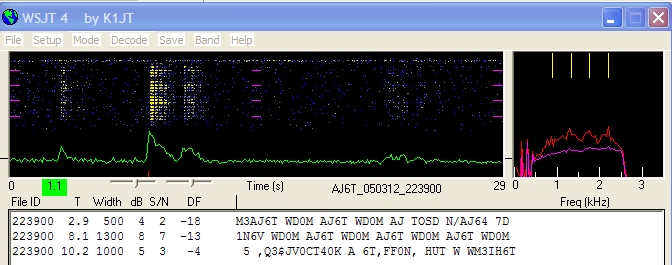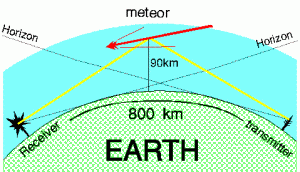
|

Pagosa Springs, Colorado |

|

or.... "Radio On the Rocks"
Although I've been a licensed amateur radio operator for over 54 years, I'm continually intrigued by different
ways to communicate by ham radio. Bouncing radio signals off ionized meteor trails isn't new - it's been done for quite some time by the military and
commercial companies. What IS new for ham operators is a way to do it on a fairly regular basis, and with good results. Over the years, while listening
on a "dead band", especially on 6 meters (50 MHz) or 2 meters (144 MHz), I've heard sudden bursts of signals on voice or morse code. Then nothing.
Turns out that they were from signals bouncing off of meteor trails.
What has made this method of enjoying ham radio a reality is a program written and developed by K1JT, Joe Taylor, a Nobel prize winner for having discovered
Binary Pulsars. Joe's program is called "WSJT", and is offered to the ham community for free. You can download a copy of the latest version at this web site:
WSJT. There is a great User's Manual that is also available, and it's a good idea to review it
at least once or twice for tips on how to use the program.

WSJT decodes very brief bursts of signals sent from a distant location that bounce off meteor trails, and back to your antenna. The program has several modes for operating on several high frequency bands, as well as bouncing signals off the moon, if you feel really ambitious! My operating is limited to 6 meters, which it turns out is the band that has the most opportunities for making a contact on HSMS. My antenna on 6 meters is a SteppIR 4 element antenna with two additional passive elements - the equivalent of a 6 element yagi. I use my Icom 756 Pro, running at about 100 watts of power, to do the rest of the work. Speaking of work, how does this thing work? The short answer is "very well", but that's not what you want to know. Transmissions are sent by tones, rather than actually speaking to someone. The tones are generated by the WSJT program, processed using the sound card in your computer, and sent through your transmitter. The reverse process decodes the received signal using the computer sound card and the WSJT program. The picture below shows what happens when a signal from a distant station bounces off a meteor, and is decoded by the WSJT program, using a mode of transmission called FSK441a.

The green line shows the received signal strength over a 30 second period. You can see several "pings" (the yellow dots) where information has been received and decoded. The decoding takes place at the bottom of the picture. It shows that AJ6T (Walt, in Saratoga, CA) is calling me. There are several standard messages that are transmitted between the two stations, which indicate that both calls have been copied, a signal report has been exchanged, the signal report has been received, a confirmation is sent indicating that the QSO is complete, and an optional "73" (best wishes) sent to indicate that all has been copied.
You will notice that on the left side of the image, the "pings" appear very intense, compared to the "pings" on the right side. Nonetheless, the very light pings also carry
information and WSJT is able to decode it very well. When listening to your radio, you will occasionally hear a burst of data through your speaker or headphones
and after awhile, you will be able to detect the different tones of the different modes used. FSK441a, which is the primary mode used on 6 meters, sounds like
a buzzsaw. A different mode, used occasionally on 6 meters, called JT6M, sounds very melodious, somewhat like a piccolo. It becomes very easy to detect
which mode is being used after a short time of listening. Here is a sample of what FSK441a sounds like:
Contrary to what you would think, although JT6M is optimized for use on 6 meters, the standard mode on 6 meters is FSK441a. The reason is that FSK441a sends data in shorter bursts, and any ping will provide intelligible, decodeable data to WSJT. JT6M takes a bit longer to provide the same information, and the "ping" has to be stronger for it to decode. At this point, if you're interested in trying WSJT, all you need is your standard radio setup that uses other digital modes like RTTY, PSK31, or any other sound card mode. If you already have the sound card interface for your radio (like the Rig Blaster), you're ready to go on WSJT!

You will also need to ensure that your computer clock is accurately set. I use a free program that sets the computer clock each day (search Google to find a program you like, or download Dimension 4). The practice for communicating using WSJT is that the station further to the west transmits on the first 30 seconds of the minute, and the other station transmits on the second 30 seconds of the minute. That requires that your computer clock be accurate to the second. OK - now how do you make a contact? The easiest way to talk to someone is to use a web "chat" page called Ping Jockey. This is where the meteor guys and gals hang out. Using Ping Jockey, you can chat with other folks, set up contacts, arrange schedules, and learn from them. They are a very helpful group. I recommend that you use the WSJT "monitor" mode first, just to get familiar with copying "pings" and seeing the information decoded. The primary calling frequency is 50.260 MHz. Once you see how that works, then jump in and have fun! Ask anyone on Ping Jockey if they would like to try a QSO (contact). They may ask you to move up or down a few KHz to leave the calling frequency clear for others. Follow their lead, and you're sure to enjoy this new mode!

My first misconception was that you had to aim your antenna toward a particular "meteor shower", as described from an astronomy perspective. That is, when there is a projected meteor shower from the Perseids, I thought you had to find out where that was in the sky and aim your antenna that direction. Ain't necessary. Just aim your antenna in the general direction of the station you would like to talk to, just as you would do on HF operations. That's close enough. How far away can you expect to talk to someone on WSJT? Typically, you can expect to talk to people within about a 1200 - 1400 mile radius. Stations closer in to you can be more difficult. If they are within about 500 miles, then you may have difficulties hearing them, due to basic physics. The sharper the angle ("the angle of incidence equals the angle of reflection"), the more you would have to elevate your antenna so the signal would bounce down closer to you. That would increase your chances.

No, you don't have to "wait" for a meteor shower. They're up there virtually all the time. Even a very small meteor will ionize the atmosphere and allow communications. Most contacts tend to happen in the morning or evening. During the day, the atmosphere is already ionized, and meteors don't seem to make as much difference. Every Saturday morning, from 1500 - 1600 UTC, there is a "Random Hour" on HSMS. Check in with the Ping Jockeys and see how many people you can talk to. As a note, most QSOs can take from 10 minutes to an hour before they are completed. You're at the mercy of "the rocks"! Be patient...The map above indicates my location in southwest Colorado with a blue dot. The stations I've talked to thus far are indicated by a red dot.
I hope this explanation of high speed meteor scatter operation tempts you to try it. It's always great to learn something new!
73,
Joe, WDØM
|